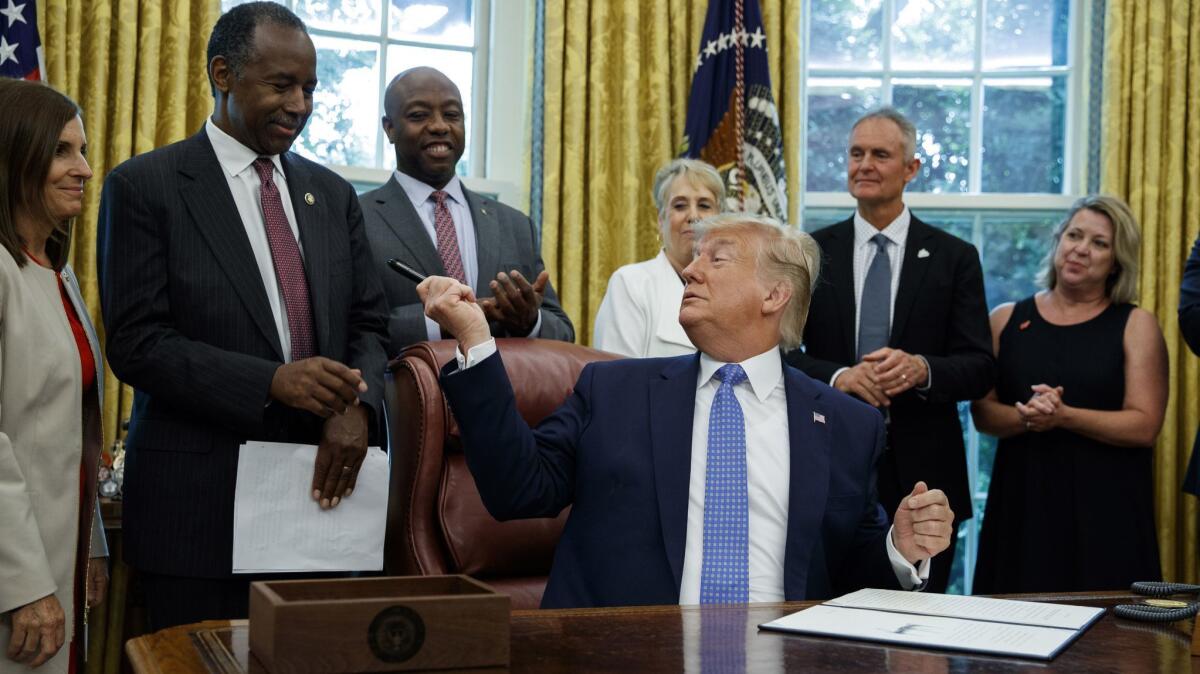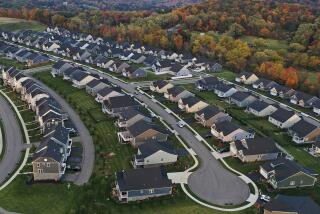Op-Ed: Public housing is suffering from a lack of funding, not an overflow of immigrants

- Share via
The Department of Housing and Urban Development has proposed a rule change that would exclude any households with immigrants in the country illegally from living in public housing or using a voucher to help pay for private market rental housing. This rule change could result in the eviction of as many as 25,000 households from public housing. In a series of recent tweets, HUD Secretary Benjamin Carson has claimed that immigrants in the country illegally are taking housing that rightfully belongs to families on the waiting list for public housing. He justified this change as an effort to “take care of your own first.” But in fact, this proposal will harm citizens and immigrants eligible to live in public housing. Despite the Trump administration’s claims, it will not appreciably reduce the wait list for public housing.
HUD’s analysis of the effect of this proposed rule change reveals that more than 70% of the people living in households that would be affected by the rule are legally entitled to live in those units and eligible to receive a subsidy. This includes an estimated 55,000 children. And none of the immigrants in the country illegally currently living in these 25,000 families directly receive so much as a penny from the government to subsidize their housing because Congress has already passed legislation that prohibits it. A previous attempt by HUD to evict households with immigrants living here illegally in 1986 was stopped by the courts because of the hardship it would create by separating families and evicting legally eligible individuals from public housing.
Carson has argued that this policy change will allow HUD to reduce the wait list for public housing, but it is unlikely that the change will make much of a difference. The 25,000 families represent about 0.5% of the total number of households currently living in public housing or using a voucher. Compare that to recent estimates of the number of households on waiting lists: 1.6 million for public housing and 2.8 million for the voucher program. In fact, the agency’s analysis indicates that fewer households from the wait list would get housing than the number of families evicted. The reason is simple: Households on the wait list are on average poorer and will therefore require larger subsidies than the families currently occupying that housing. Vilifying immigrants in the country illegally may score points for President Trump with his supporters, but purging them from public housing will do little to ease the long wait for public housing.
If the administration were genuinely concerned about the public housing shortage, it would push to meet the capital budget requests of public housing agencies.
If the administration were genuinely concerned about the shortage of public housing, it would push to meet the capital budget requests of public housing agencies. Tens of thousands of existing housing units are essentially uninhabitable for lack of maintenance.
In 2010, a national research report estimated a backlog of $21 billion in capital needs for public housing units across the U.S., an amount that would increase to about $30.6 billion by 2018. A 2017 report on the New York City Housing Authority estimated that the capital needs for public housing in New York City alone would reach nearly $32 billion over the next five years.
Despite the obvious needs, Congress appropriated only $18.5 billion between 2010 and 2018 for public housing’s capital fund. While previous administrations have underfunded the capital budget for public housing, the Trump administration has taken capital funding neglect to a new low: for fiscal years 2019 and 2020 the Trump administration proposed no funding for public housing’s capital budget.
Enter the Fray: First takes on the news of the minute »
The lack of funding for maintenance means ever more units are taken offline. Currently, about 61,000 units of public housing are vacant. While some of these units are waiting for a new household to move in, the vast majority are likely empty because they cannot safely accommodate a tenant. And even these reported vacancies probably do not capture the extent of all the true vacancies in public housing because of neglect of capital needs. One study estimated that about 6,000 public housing units are lost each year because public housing authorities could not afford to make needed capital improvements.
Evicting households with immigrants in the country illegally won’t correct this bigger problem of deteriorating housing stock. Only fully funding the capital needs of public housing could have a significant effect on the wait list for public housing by bringing more units back online. It would also improve the living conditions for untold numbers of current residents who suffer in poorly maintained housing that harms their health and well-being.
Sensible, long-term investment in public housing will require commitment by the Trump administration to negotiate with Congress to pass a reasonable budget for HUD. Unfortunately, this may be too much to expect from an administration that seems more intent on blaming immigrants for all manner of social problems than actually trying to solve the nation’s deepening affordable housing crisis.
Ryan Allen and Edward G. Goetz are professors of urban planning at the Humphrey School of Public Affairs at the University of Minnesota.
More to Read
A cure for the common opinion
Get thought-provoking perspectives with our weekly newsletter.
You may occasionally receive promotional content from the Los Angeles Times.










